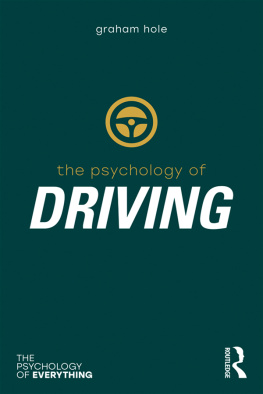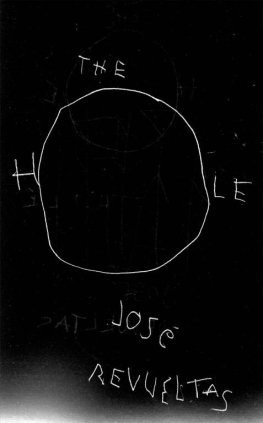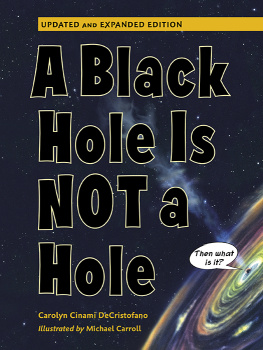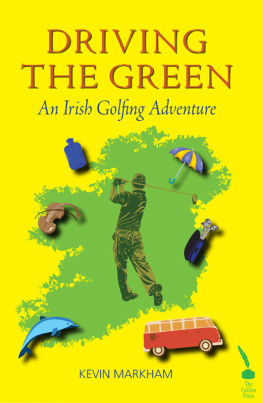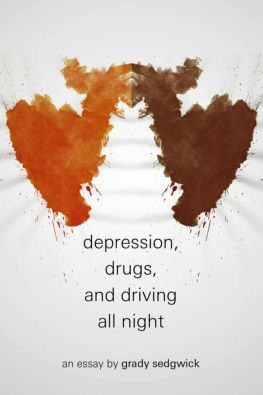Hole - Psychology of Driving
Here you can read online Hole - Psychology of Driving full text of the book (entire story) in english for free. Download pdf and epub, get meaning, cover and reviews about this ebook. year: 2018, publisher: Taylor & Francis (CAM), genre: Religion. Description of the work, (preface) as well as reviews are available. Best literature library LitArk.com created for fans of good reading and offers a wide selection of genres:
Romance novel
Science fiction
Adventure
Detective
Science
History
Home and family
Prose
Art
Politics
Computer
Non-fiction
Religion
Business
Children
Humor
Choose a favorite category and find really read worthwhile books. Enjoy immersion in the world of imagination, feel the emotions of the characters or learn something new for yourself, make an fascinating discovery.
Psychology of Driving: summary, description and annotation
We offer to read an annotation, description, summary or preface (depends on what the author of the book "Psychology of Driving" wrote himself). If you haven't found the necessary information about the book — write in the comments, we will try to find it.
Hole: author's other books
Who wrote Psychology of Driving? Find out the surname, the name of the author of the book and a list of all author's works by series.
Psychology of Driving — read online for free the complete book (whole text) full work
Below is the text of the book, divided by pages. System saving the place of the last page read, allows you to conveniently read the book "Psychology of Driving" online for free, without having to search again every time where you left off. Put a bookmark, and you can go to the page where you finished reading at any time.
Font size:
Interval:
Bookmark:
Visual perception is clearly very important for driving: try driving for any length of time with your eyes shut and youll see what I mean. Many accidents seem to involve perceptual errors. Every year in the UK, a contributory factor in about 45% of reported road accidents is that a driver or rider failed to look properly. The second most common factor, accounting for a further 25% of accidents, is driver/rider failed to judge other persons path or speed. In many collisions, at least one of the drivers claimed that he or she failed to see the other vehicle beforehand. The victims of these looked but failed to see accidents are often cyclists and motorcyclists.
Often, its suggested that these accidents especially the ones involving two-wheelers are due to limitations in peoples eyesight (in the sense of the sharpness of vision thats measured by an eyechart). Sometimes its claimed they are due to the visual systems deficiencies, such as the fact that our retinal image is poor or because we are blind during eye movements. If you actually understand how the visual system works, you realise that none of these claims is true. Any problems really lie in the drivers brain, not the eyeballs. To explain what I mean by this, I need to tell you a bit about the visual system and what its designed to do.
While you are driving, your brain rapidly and apparently effortlessly builds up an impression of a stable, richly detailed 3D world, from a constantly changing array of shapes and edges. Your brain decides which contours belong together as objects, even when one object is partially obscured by another (such as a pedestrian peeking out from behind a bus). It distinguishes between different kinds of movement movement produced by your vehicle, by that pedestrian and by your eyes rapidly moving from looking in the mirror to scanning the road ahead.
To achieve this feat, a phenomenal amount of information- processing goes on behind the scenes. The eye is not a camera; it is just part of a set of neural systems that use light reflected from objects in order to acquire important information about the world. Each eye produces an upside-down (yes, really!), dim, blurry and shaky retinal image, about the size of a postage stamp. No one is looking at that image; its just the starting point for the processes underlying visual perception. The eye transmits information to the brain in the form of patterns of electrical impulses, which the brain then interprets.
Our subjective impressions give us a very false idea of how our perceptual processes actually operate. Did you notice the intermittent darkness produced by the dozen or so blinks that you made while you read this page or the way your eyes moved jerkily along each sentence? In change-blindness demonstrations, observers have to spot the difference between two images that are displayed alternately. It is surprisingly difficult to find even quite major differences, unless you are looking directly at the change as it happens. The change-blindness technique simulates what happens every time you move your eyes: your brain discards most of the information obtained from where you were looking previously, retaining only the gist of the scene. Everywhere you look, the scene appears highly detailed, but this is what Ronald Rensink and others have called the grand illusion of visual consciousness. Youre unaware that where you looked previously is represented only very coarsely by the brain because you are not looking there now.
The brain is faced with a huge problem: for visual information to be of any use, it has to be interpreted very rapidly, but there is a vast amount of information in any scene. Therefore the brain needs to be very selective. It is optimised for detecting change of some kind. Changes in space or time have biological relevance; constant states do not. It is the abrupt change produced by the edge of a cliff that you need to worry about, not the flat expanse of grassland leading up to it.
At all levels, from the retina up to higher brain regions, the visual system is beautifully designed for efficient information-acquisition. Firstly, only a very small part of the scene in front of you is analysed in any detail. Fine-detail vision is confined to a central region of each retina, called the fovea. Beyond this tiny region, just 1.5 millimetres (mm) in diameter, acuity (sharpness of vision) becomes progressively poorer, so that in our extreme peripheral vision, we can perceive little more than a vague sensation of movement (see ).
The lack of acuity in peripheral vision is not a problem in practice, because when we look at anything, eye movements ensure that its image falls upon the fovea. Normal vision consists of brief fixations (about three per second), linked by eye movements (mainly rapid, large-scale movements called saccades). A shift of fixation occurs either because something attracts our attention or on the basis of our knowledge and expectations about where it would be useful to look next (more on this later).

This is a brilliantly elegant way to solve the problem of information overload. We dont need to store the entire outside world in our heads; we just sample information from the world as and when we need it, by moving our eyes to where that information might be located.
Another way in which the brain copes with information overload is by processing visual information within only a restricted range of what is potentially available. Any scene contains information at different levels of detail. These are reflected in the spatial frequency content of the image, how often a pattern changes from light to dark as one moves across it in any particular direction. High spatial frequencies contain information about fine detail in an image (such as the contours produced by the leaves on a tree). Low spatial frequencies carry information about larger-scale changes in an image (such as the gross difference between a tree and its background). shows the results of filtering an image to selectively remove the high spatial frequencies.
Different tasks may require analysis at different spatial scales. For many driving-related tasks (such as rapid scene analysis, lane guidance and collision-avoidance), we dont actually need fine-detail (high spatial frequency) information; fairly coarse (medium- to low frequency) information will suffice. The car in remains easily identifiable despite the loss of information about its details.
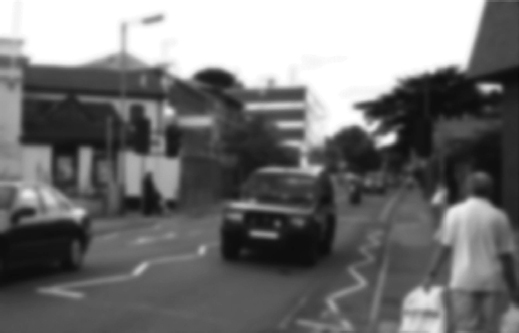
You might be wondering how I can argue that eyesight limitations are not the cause of accidents when Ive spent so much time describing the visual systems limitations. Thats because these deficiencies are only a problem if you are locked into the misconception that vision somehow consists of us seeing our retinal image. The retinal image might be fairly rubbish, but seeing is not.
Heres an illustration of how much processing goes on and what it can achieve. Each eye contains 127 million light-sensitive cells (photoreceptors). Seven million of these are cones, providing your fine-detail colour vision in daylight. The rest are rods, providing you with coarser monochromatic vision in twilight conditions. Your sharpest vision is primarily based on just 200,000 cones in the very centre of each fovea. However the resolution of the visual system is far better than you would expect on the basis of the size of the photoreceptors themselves. The smallest detectable misalignment between two vertical lines is a
Font size:
Interval:
Bookmark:
Similar books «Psychology of Driving»
Look at similar books to Psychology of Driving. We have selected literature similar in name and meaning in the hope of providing readers with more options to find new, interesting, not yet read works.
Discussion, reviews of the book Psychology of Driving and just readers' own opinions. Leave your comments, write what you think about the work, its meaning or the main characters. Specify what exactly you liked and what you didn't like, and why you think so.

